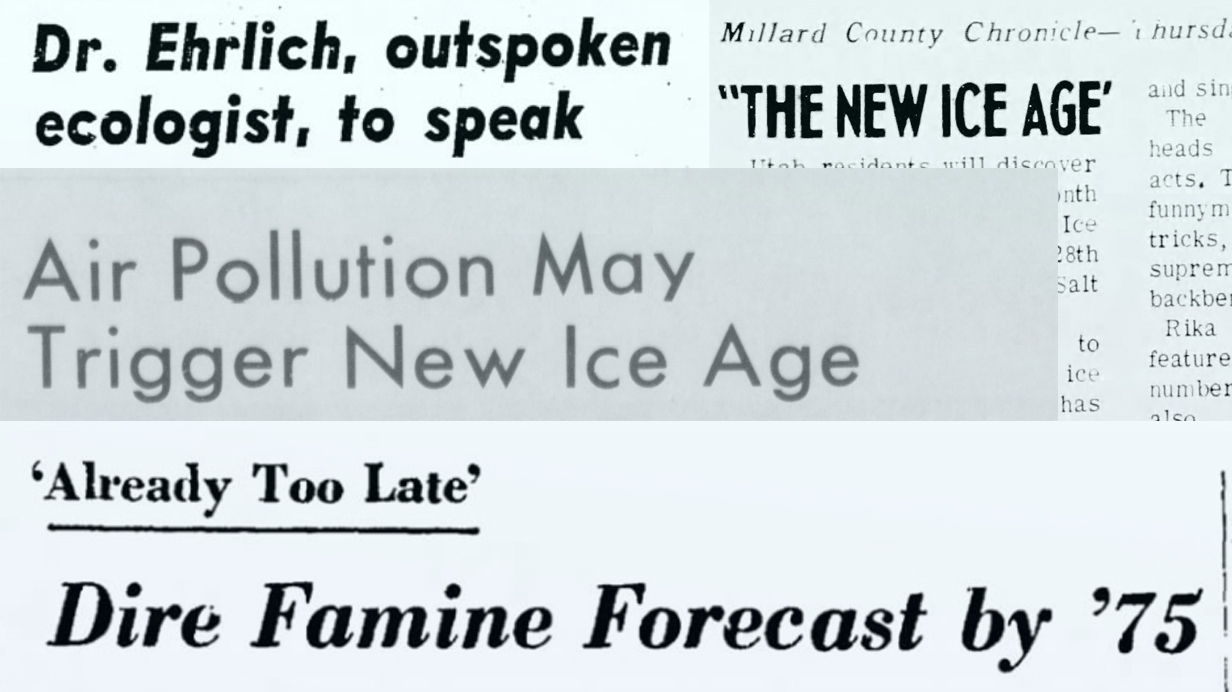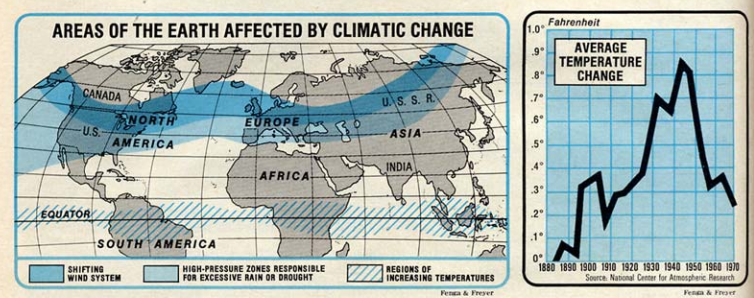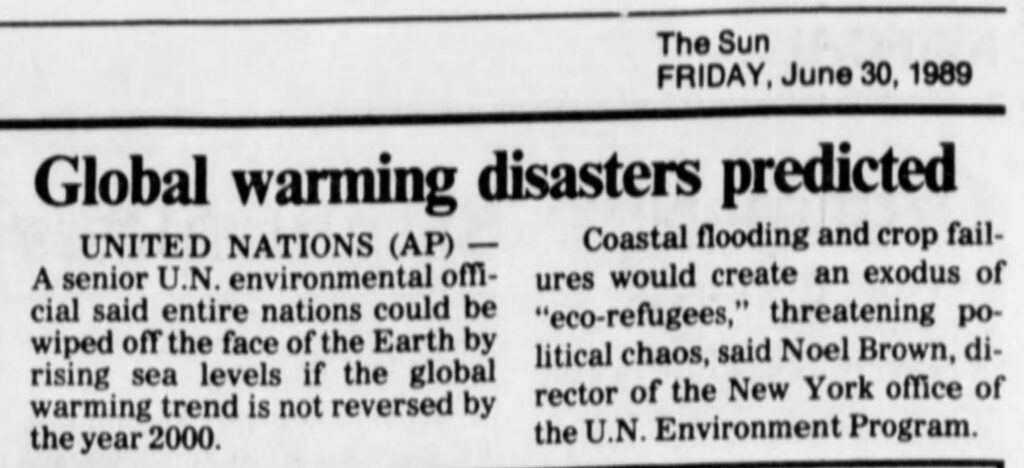
With a warmer-than-usual winter sparking a new round of climate change fearmongering, Dan O’Donnell runs down 50-plus years of failed doomsday predictions
Mar. 13, 2024
Perspective by Dan O’Donnell
Wisconsin officially had the warmest weather ever (or at least ever since records started being kept) and already the predictions are rolling in that warm winters are the new normal because of climate change. In fact, those are some of the tamer predictions.
“When we think about climate, we all know that things are not getting better,” NBC weatherman Al Roker said this week while discussing his attendance at the Aspen Institute Climate Summit. “This is a really important topic. In fact, I consider it [and] a number of people consider it the major issue facing our country for the day and as far as our survival is concerned.”
Such doomsday predictions have been commonplace for more than 50 years now, but here’s the thing: Ever since they were first made, they have been dead wrong.
In 1967, researcher Paul Ehrlich said “the time of famines is upon us” and will be most disastrous by 1975. There were no famines, but that didn’t stop Ehrlich from predicting in 1970 that “the oceans will be as dead as Lake Erie in less than a decade, the DDT in our fatty tissues has reached levels high enough to cause brain damage and cirrhosis of the liver, and America will be subject to water rationing by 1974 and food rationing by 1980.

None of that happened. And neither did the “coming ice age,” which Newsweek Magazine infamously predicted in an article entitled “The Cooling World.”
“There are ominous signs that the earth’s weather patterns have begun to change dramatically,” the piece gravely began, “and that these changed may portend a drastic decline in food production—with serious political implications for just about every nation on earth.
Members of the public throughout the 70s were hard-pressed to keep up with all the global cooling predictions.
“The evidence in support of these predictions has now begun to accumulate so massively that meteorologists are hard-pressed to keep up with it.”
Members of the public throughout the 70s were hard-pressed to keep up with all the global cooling predictions:
A headline in the Washington Post screamed “Colder Winters Held Dawn of New Ice Age.” Science Magazine predicted “Another Ice Age.” The New York Times ran a story titled “Scientists Ask Why World Climate is Changing; Major Cooling May Be Ahead” and another called “A Major Cooling Widely Considered to Be Inevitable.”
Even America’s most trusted news anchor, Walter Cronkite, told viewers in 1972 that “British professor Hubert Lamb says that a new ice age is creeping over the Northern Hemisphere.”
Of course, no ice age ever came and just eight years later Cronkite was predicting devastation from global warming.
“Increased reliance on coal is a crucial part of the Carter Administration’s energy program,” he said during a newsast in 1980, “but the Senate Energy and Natural Resources Committee heard warnings today that a coal-burning society may be making things hot for itself.”
He then tossed to reporter Nelson Benton on Capitol Hill for a dire prediction:
“One scientist put the urgency of the greenhouse potential in biblical terms, citing the warning given to Noah in the Old Testament: ‘Noah knew trouble was coming,’ he said, ‘and he prepared for it.’”
The 1980s saw doomsday predictions preparing the public for untold dangers from warming and acid rain. Mostafa Tolba, executive director of the UN’s Environment Program said in 1982 that within 20 years there would be “an environmental catastrophe which will witness devastation as complete, as irreversible as any nuclear holocaust.”
By 2002, it was pretty clear that no such environmental holocaust was imminent.
Still, in 1988 the AFP predicted the destruction of the Maldives as “a gradual rise in average sea level” would flood the islands, but noted that “the end of the Maldives and its 200,000 people could come sooner if drinking water supplies dry up by 1992, as predicted.”
Spoiler: Drinking water supplies didn’t dry up by 1992.
The late 1980s also saw landmark testimony before Congress by Dr. James Hansen, who sparked fears of the Greenhouse Effect dramatically warming the earth. He predicted that by 2009 “The West Side Highway [which runs along the Hudson River in New York City] will be under water.”
It wasn’t. It was fine, and so too were the “entire nations” that the Associated Press predicted in 1989 would be “wiped off the face of the Earth by rising sea levels if the global warming trend is not reversed by the year 2000.”

This may come as a surprise, but there was not a single nation wiped off the face of the Earth because of rising sea levels in the 1990s. There were, however, a whole lot of terrible predictions.
In February 1993, Thomas Lovejoy, the Smithsonian Institution’s assistant secretary for Environmental and External Affairs said he was “utterly convinced that most of the great environmental struggles will be either won or lost in the 1990s and by the next century it will be too late.”
The next century came, and it wasn’t too late for either humanity to save itself or for climate alarmists to make more terrible predictions.
In 2000, the UK Independent cited Dr. David Viner, a senior research scientist at the climatic research unit of the University of East Anglia in reporting that “within a few years winter snowfall will become ‘a very rare and exciting event.’
’Children just aren’t going to know what snow is,’ he said.”
That paled in comparison to a secret Pentagon report obtained by the UK Guardian in 2004 that warned that “major European cities will be sunk beneath rising seas as Britain is plunged into a ‘Siberian’ climate by 2020. Nuclear conflict, mega-droughts, famine and widespread rioting will erupt across the world.
“The document predicts that abrupt climate change could bring the planet to the edge of anarchy as countries develop a nuclear threat to defend and secure dwindling food, water and energy supplies.
“An imminent scenario of catastrophic climate change is ‘plausible and would challenge United States national security in ways that should be considered immediately’, they conclude. As early as next year [2005] widespread flooding by a rise in sea levels will create major upheaval for millions.”
All of that was supposed to happen by 2020…and none of it ever did.
But the fear of putting out yet another wrong doomsday prediction didn’t stop ABC News from running a special in 2008 entitled “Earth 2100: The Final Century of Civilization?”, which forecast that as early as 2015, New York City would be under water and widespread famine and drought would lead to global instability.
“It’s June 8th, 2015,” one character in the special tells the camera. “A carton of milk is $12.99. Gas has reached over $9 a gallon. I’m scared s***less right now.”
The year after Earth 2100 came out, in 2009, Al Gore predicted that the polar ice caps would be ice free by 2016.

“Some of the models suggest that there is a 75% chance that the entire north polar ice cap during some of the summer months could be completely ice-free within the next five to seven years,” he said.
Of course, the ice caps didn’t melt. Nine years later, they’re just fine. New York isn’t underwater, humanity isn’t running out of food, children know what snow is, and we’re not in a new ice age.
Every single prediction—every single one—has failed to come true, but that isn’t stopping a new generation of alarmists from predicting that more death and destruction is just around the corner.
“The world is going to end in 12 years if we don’t address climate change,” New York Congresswoman Alexandria Ocasio-Cortez told an audience in 2019, calling the fight against it “our World War II.”

Is it, though? Is it really? Because after more than 50 years of being told that the end is nigh, it’s become impossible to believe.
That’s the thing about doomsday predictions—every single one ever made has by definition been wrong. The earth is still spinning, humanity is still thriving, and the only prediction that can be made with absolute, 100 percent certainty is that we’re in for another 50 years of failed predictions.